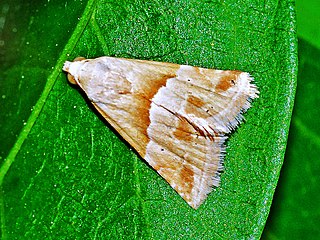
The November moth is a moth of the family Geometridae. The species was first described by Michael Denis and Ignaz Schiffermüller in 1775. It can be found in the Palearctic realm in western Europe from central Scandinavia to the Mediterranean the Caucasus and western Russia.

The goldenrod pug is a moth of the family Geometridae. The species was first described by Henry Doubleday in 1861. It is found throughout the Palearctic region and parts of the Near East. In the British Isles it is widespread but rather locally distributed.

Agrotis segetum, sometimes known as the turnip moth, is a moth of the family Noctuidae. The species was first described by Michael Denis and Ignaz Schiffermüller in 1775. It is a common European species and it is found in Africa and across Eurasia except for the northernmost parts.

The large yellow underwing is a moth, the type species for the family Noctuidae. It is an abundant species throughout the Palearctic realm, one of the most common and most familiar moths of the region. In some years the species is highly migratory with large numbers appearing suddenly in marginal parts of the range.

Callistege mi, the Mother Shipton moth, is a moth of the family Erebidae. It was classified by Carl Alexander Clerck in 1759, and is also known under the name of Euclidia mi. In Finnish it is known as piirtoyökkönen and in German as Scheck-Tageule.

Agrochola circellaris, The Brick, is a species of moth of the family Noctuidae. It is distributed throughout most of Europe, Asia Minor and Armenia.

The mouse moth is a moth of the family Noctuidae. It is a widespread species with a Holarctic distribution.

Apamea crenata, known as the clouded-bordered brindle, is a moth in the Noctuidae family. It is distributed throughout the Palearctic realm.

Apamea remissa, the dusky brocade, is a species of moth of the family Noctuidae. It is distributed throughout Europe and Turkey, ranging across the Palearctic realm to Siberia, Manchuria and Japan. It has also been reported from Alaska.

The herald is a moth of the family Erebidae. The species was first described by Carl Linnaeus in his 1758 10th edition of Systema Naturae. It is found throughout the Palearctic and Nearctic (Holarctic).

Theretra latreillii, the pale brown hawk moth, is a moth of the family Sphingidae described by William Sharp Macleay in 1826. It is found in most of Asia, including Borneo, China, Hong Kong, the Philippines, Taiwan and also in the tropical regions of Australia.
The Zulu serotine, also called the Zulu pipistrelle, aloe bat, or aloe serotine, is a species of vesper bat found in Angola, Botswana, Democratic Republic of the Congo, Ethiopia, Kenya, Malawi, Namibia, South Africa, South Sudan, Uganda, Zambia, and Zimbabwe. Its natural habitats are dry savanna, moist savanna, and hot deserts.

Haimbachia is a genus of moths of the family Crambidae.

Cerastis leucographa, the white-marked, is a moth of the family Noctuidae. The species was first described by Michael Denis and Ignaz Schiffermüller in 1775. It is found in most of Europe, east to Russia, through the Palearctic up to Japan.

Eublemma parva, the small marbled, is a moth of the family Erebidae. The species was first described by Jacob Hübner in 1808.
Haimbachia albescens, the silvered haimbachia moth, is a moth in the family Crambidae. It was described by Hahn William Capps in 1965. It is found in North America, where it has been recorded from Indiana, Iowa, Maryland, New Jersey, West Virginia, Illinois and southern Ontario.
Haimbachia mlanjella is a moth in the family Crambidae. It was described by Stanisław Błeszyński in 1961. It is found in Malawi.
Haimbachia proalbivenalis is a moth in the family Crambidae. It was described by Stanisław Błeszyński in 1961. It is found in Nigeria, the Gambia and India.
Haimbachia proaraealis is a moth in the family Crambidae. It was described by Stanisław Błeszyński in 1961. It is found on Mahé in Seychelles and in South Africa and Zimbabwe.
Haimbachia strigulalis is a moth in the family Crambidae. It was described by George Hampson in 1896. It is found in India, Sri Lanka and China.












